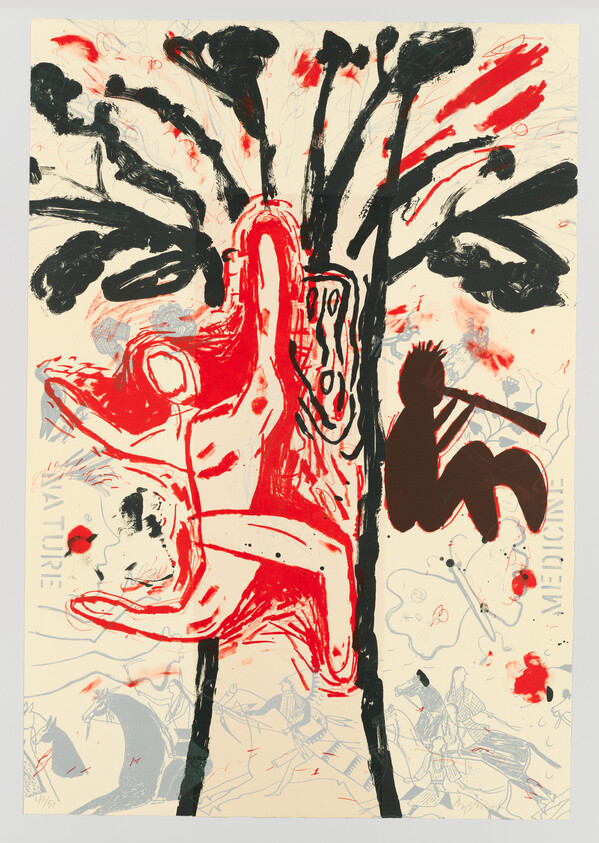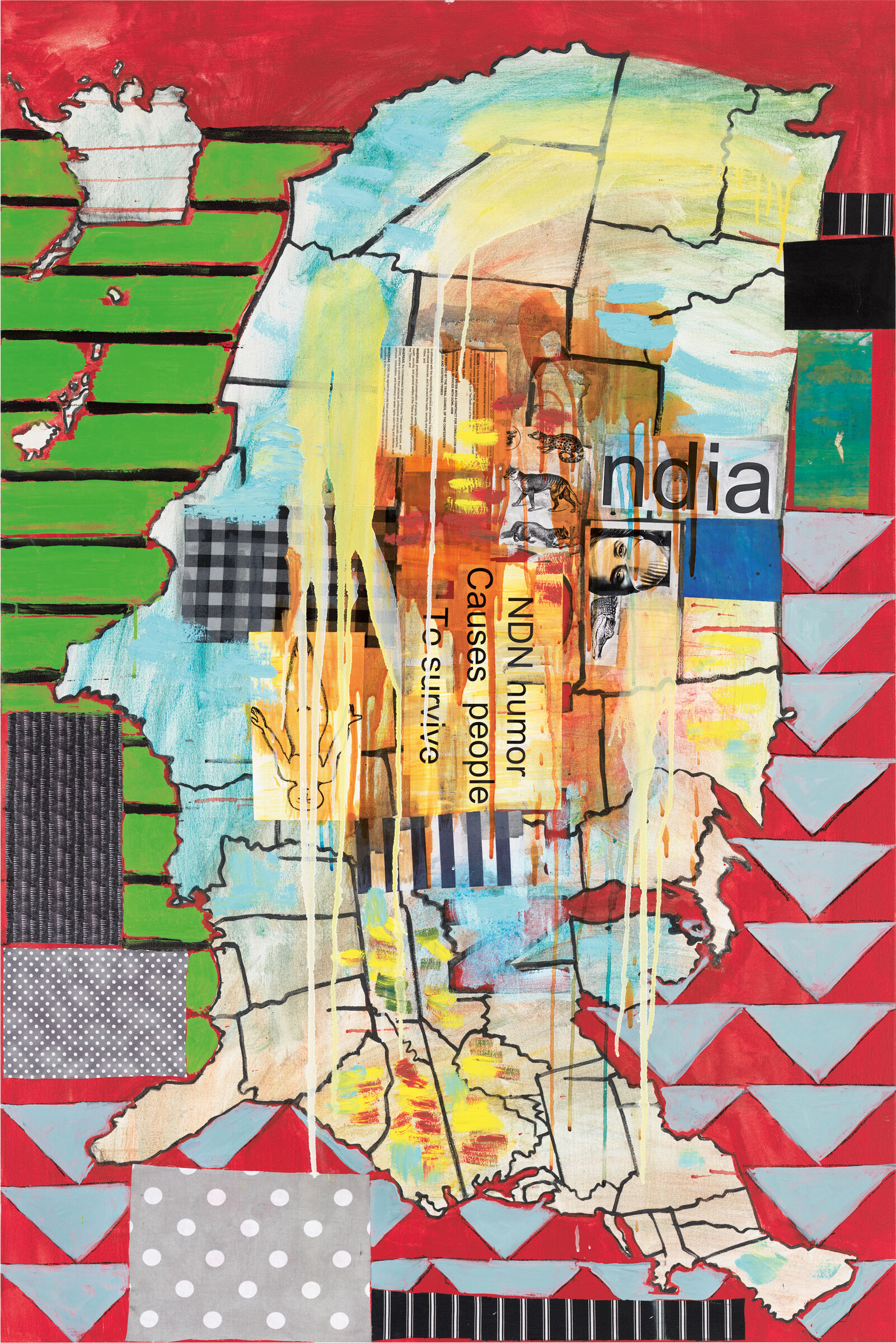Visual description
Survival Suite: Nature/Medicine is a vertical lithograph made with chine-collé, about 36 inches tall by 25 inches wide. This is one of a suite of prints in which Smith identifies and depicts the four main elements that she believes Indigenous people need for survival: tribe/community, nature/medicine, wisdom/knowledge, and humor. Smith has said: “I am telling stories about hope with humor. We wouldn’t be here if we didn’t have hope.”
On a beige background are large painterly black and bright red marks and smaller more tightly drawn gray drawings. Drawn with thick black painterly lines is a gestural tree that fills the center of the image. The trunk begins at the bottom edge and its branches fill the top third of the image. The branches are loose, expressive as if done with a quick drag of a paintbrush with thick rounded splotches like a cluster of leaves. Scattered red marks between the limbs emphasize the bursting branches. There is a face in the top of the tree trunk that is drawn simply with wavy lines, circular eyes and a mouth and a long curved line as a nose. Starting by the left edge of the image, overlapping the tree and running up next to the face, is a red figure about half the size of the image and centered in the middle. The figure faces the right and is on one knee, with both of their long arms raised in the air. The figure is drawn without hands, feet or facial features, however its energy can be felt by short red marks built up around the outline of the figure and by the figure’s pose, almost as if they’re mid-leap, arms outstretched. Just to the right of the tree’s trunk is another figure of a brown silhouette outlined by thin red marks. The Kokopelli figure is sitting with their knees bent holding a flute. Small smears, drops, and quick short lines are scattered throughout the image.
Underneath the bold black and red colors of the tree are two figures and very faint, pale bluish gray drawings and text. The figures appear as if they might have been the first layer of printed color, with the black and red layers coming afterwards, printed on top of the quiet underlayer. Interspersed between the top of the tree’s branches are energetic twisting and curving gray lines. In the middle to the left of the tree is a small turkey, a long sock, and another bird with a small beak which are all rendered representationally. Underneath is the loose outline of a person’s side profile with short marks for hair, an outstretched arm and hand and leg, and a large red dot like a rosy cheek. To the left of the face by the edge of the image the word “NATURE” is printed sideways in a stencil-like font, which is mirrored on the far right with the word “MEDICINE”. To the right of the tree under its branches are two very small gray figures, a cartoon-like outlined figure on the left, overlapping the tree trunk with three circles for eyes and mouth, and to the right is a person holding plants and wearing a draped outfit with long hair. There are other shapes in this same gray color such as a flower plant with heart shaped leaves and a large butterfly with squiggly wings. Spanning across the entire bottom of the image is a scene in gray of five or six Indigenous people riding horses in the style of ledger drawings, a narrative painting style predominantly practiced by Indigenous peoples of the American Great Plains in the early 1900s
Not on view
Date
1996
Classification
Prints
Medium
Lithograph with chine-collé
Dimensions
Sheet (irregular): 36 1/8 × 24 13/16 in. (91.8 × 63 cm)
Accession number
2003.28.3
Series
Survival Suite, 1996
Edition
40/50 | 6 APs, 8 OPs
Publication
Printed by Lawrence Lithography Workshop; published by Zanatta Editions
Credit line
Gift of the Joe and Barb Zanatta Family in honor of Jaune Quick-to-See Smith
Rights and reproductions
Courtesy the artist and the Garth Greenan Gallery, New York
Audio
-
0:00
Verbal Description: Survival Suite: Nature/Medicine, 1996
0:00
Narrator: Survival Suite: Nature/Medicine is a vertical lithograph made with chine-collé, about 36 inches tall by 25 inches wide. This is one of a suite of prints in which Smith identifies and depicts the four main elements that she believes Indigenous people need for survival: tribe/community, nature/medicine, wisdom/knowledge, and humor. Smith has said: “I am telling stories about hope with humor. We wouldn’t be here if we didn’t have hope.”
On a beige background are large painterly black and bright red marks and smaller more tightly drawn gray drawings. Drawn with thick black painterly lines is a gestural tree that fills the center of the image. The trunk begins at the bottom edge and its branches fill the top third of the image. The branches are loose, expressive as if done with a quick drag of a paintbrush with thick rounded splotches like a cluster of leaves. Scattered red marks between the limbs emphasize the bursting branches. There is a face in the top of the tree trunk that is drawn simply with wavy lines, circular eyes and a mouth and a long curved line as a nose. Starting by the left edge of the image, overlapping the tree and running up next to the face, is a red figure about half the size of the image and centered in the middle. The figure faces the right and is on one knee, with both of their long arms raised in the air. The figure is drawn without hands, feet or facial features, however its energy can be felt by short red marks built up around the outline of the figure and by the figure’s pose, almost as if they’re mid-leap, arms outstretched. Just to the right of the tree’s trunk is another figure of a brown silhouette outlined by thin red marks. The Kokopelli figure is sitting with their knees bent holding a flute. Small smears, drops, and quick short lines are scattered throughout the image.
Underneath the bold black and red colors of the tree are two figures and very faint, pale bluish gray drawings and text. The figures appear as if they might have been the first layer of printed color, with the black and red layers coming afterwards, printed on top of the quiet underlayer. Interspersed between the top of the tree’s branches are energetic twisting and curving gray lines. In the middle to the left of the tree is a small turkey, a long sock, and another bird with a small beak which are all rendered representationally. Underneath is the loose outline of a person’s side profile with short marks for hair, an outstretched arm and hand and leg, and a large red dot like a rosy cheek. To the left of the face by the edge of the image the word “NATURE” is printed sideways in a stencil-like font, which is mirrored on the far right with the word “MEDICINE”. To the right of the tree under its branches are two very small gray figures, a cartoon-like outlined figure on the left, overlapping the tree trunk with three circles for eyes and mouth, and to the right is a person holding plants and wearing a draped outfit with long hair. There are other shapes in this same gray color such as a flower plant with heart shaped leaves and a large butterfly with squiggly wings. Spanning across the entire bottom of the image is a scene in gray of five or six Indigenous people riding horses in the style of ledger drawings, a narrative painting style predominantly practiced by Indigenous peoples of the American Great Plains in the early 1900s.


